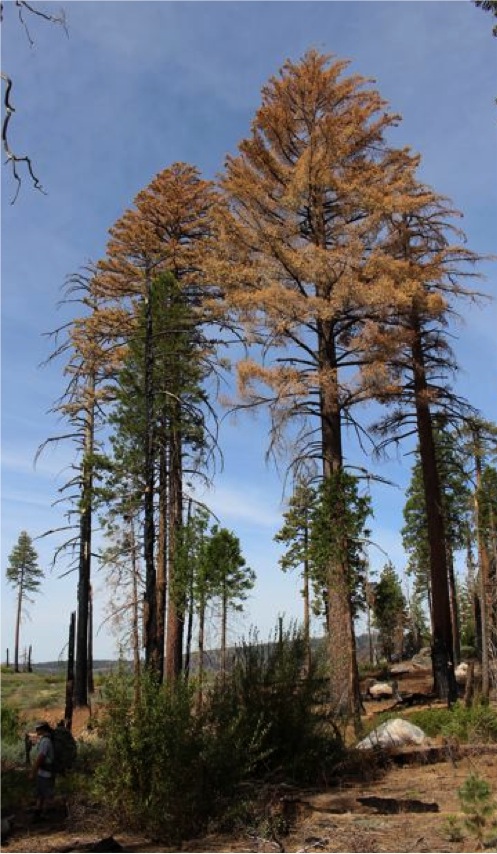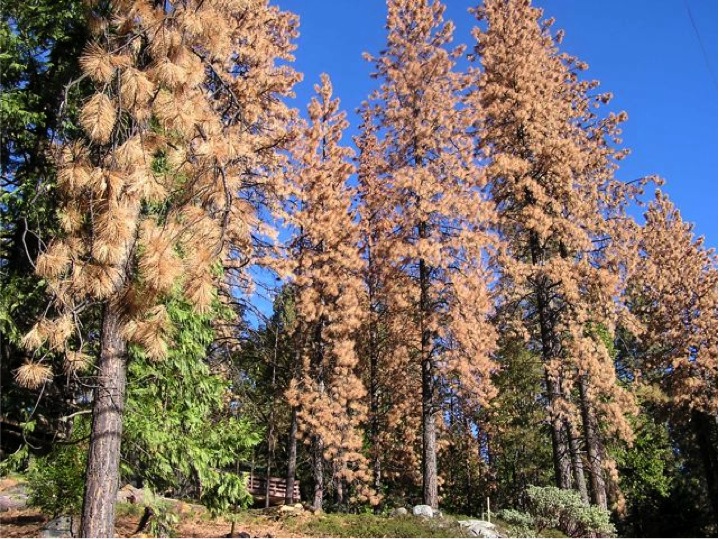 Over the past four decades there have been a number of droughts, but the current four-year drought has resulted in higher tree mortality than previously seen. Areas south of Yosemite on the Sierra and Sequoia National Forests have been especially hard hit, with hundreds of thousands of trees dying.
Over the past four decades there have been a number of droughts, but the current four-year drought has resulted in higher tree mortality than previously seen. Areas south of Yosemite on the Sierra and Sequoia National Forests have been especially hard hit, with hundreds of thousands of trees dying.
In Calaveras County (the northern third of the Stanislaus Forest), drought mortality and outbreaks of bark beetles have only been moderate, but on the MiWok and Groveland District areas of the Stanislaus Forest and on private low-elevation forested lands, large patches of dead pines are evident. Worse, the die-off is still expanding.
As shown in the photo at left, big sugar pines have been especially vulnerable to drought stress. Even without bark beetle attacks, old growth sugar pines have been dying across the Stanislaus Forest and Yosemite Park in large numbers. Many sugar pines centuries old have died.
However it is the ponderosa pine that has suffered the most widespread mortality, due to that species’ susceptibility to bark beetles. When drought leaves little or no water for the pines to take up from the soil, their sap production fades. Without sap to repel bark beetles boring in through the bark, the trees are overwhelmed as countless beetles successfully attack. The beetles lay eggs in the cambium beneath the bark, and the larvae then girdle the tree as they create tunnels through the cambium layer.
Across the Northern Yosemite region, CSERC staff has observed large concentrations of beetle-killed pines across most of the lower elevation forests, especially on ridges and south-facing slopes. The consequences of such a massive wave of dying trees will last for decades. If the die-off worsens before deep soaking rains and snow-melt finally rejuvenate stressed trees, it is likely that the majority of large, older pines in low elevations will be killed. Such a concentrated die off of centuries-old trees could combine with the high severity damage caused by the Rim Fire, leaving few remaining ancient trees.  While the general public may barely notice the bark beetle epidemic, the die-off of so many old growth conifers (especially sugar pines and ponderosa pines) diminishes critical habitat for owls, pileated woodpeckers, goshawks, flying squirrels, and other old growth-dependent species. Unless the winter season turns out to be sufficiently wet to invigorate the trees and cold enough to kill back the beetles, then conifer mortality is likely to continue.
While the general public may barely notice the bark beetle epidemic, the die-off of so many old growth conifers (especially sugar pines and ponderosa pines) diminishes critical habitat for owls, pileated woodpeckers, goshawks, flying squirrels, and other old growth-dependent species. Unless the winter season turns out to be sufficiently wet to invigorate the trees and cold enough to kill back the beetles, then conifer mortality is likely to continue.

